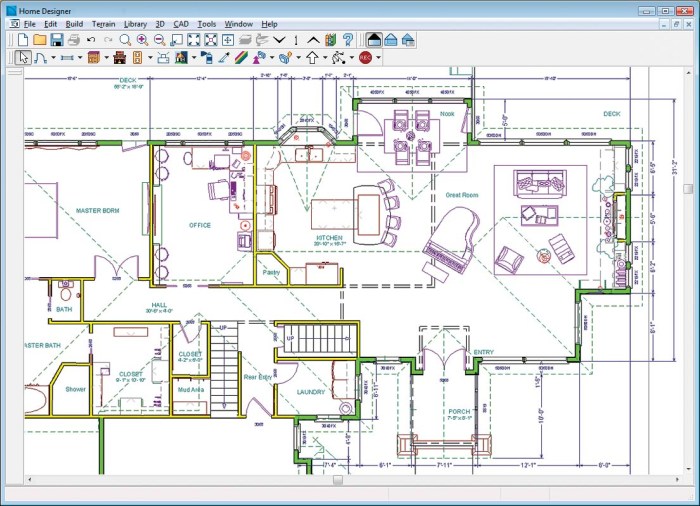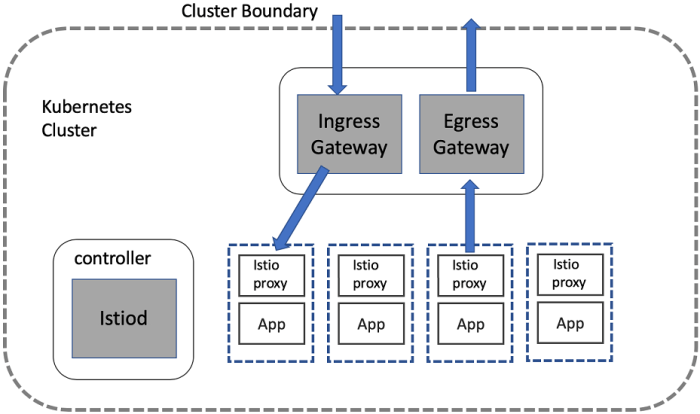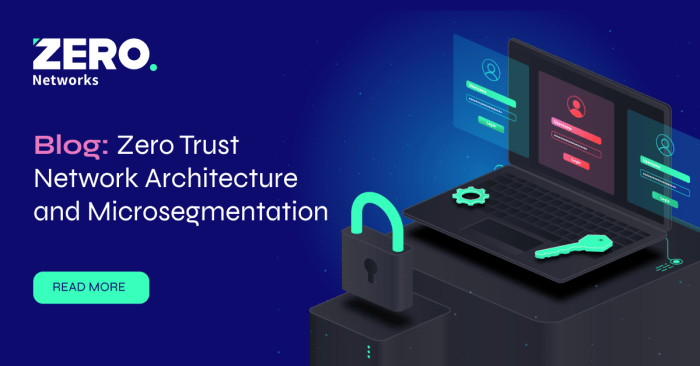Designing resilient cloud network architectures is crucial for modern businesses. This comprehensive guide delves into the key principles, strategies, and technologies essential for building robust and reliable networks. From understanding resilience characteristics to implementing fault tolerance mechanisms, this document will equip you with the knowledge to architect a cloud network capable of withstanding and recovering from potential failures.
The evolving landscape of cloud computing necessitates proactive strategies for maintaining high availability and data integrity. This guide provides a structured approach to building a resilient cloud infrastructure, considering factors like diverse network paths, load balancing, security, and disaster recovery planning. By exploring case studies and emerging technologies, we will illustrate the practical application of these concepts and address the unique challenges faced by organizations.
Defining Resilience in Cloud Networks
Cloud network resilience is critical for maintaining business continuity and operational efficiency in today’s digital landscape. A resilient cloud network can withstand and recover from various disruptions, ensuring uninterrupted service delivery. This robust design minimizes downtime, safeguards data integrity, and protects against potential threats.Resilient cloud network architecture is not merely about preventing failures; it’s about proactively designing systems that can adapt and recover quickly when failures inevitably occur.
This proactive approach encompasses redundancy, fault tolerance, and diverse network paths to ensure continuous operation.
Key Characteristics of a Resilient Cloud Network Architecture
Resilient cloud network architectures exhibit several key characteristics. These include fault tolerance, redundancy, rapid recovery mechanisms, and diverse network paths. A resilient network design is designed to withstand and recover from various failures with minimal disruption to service.
Types of Cloud Network Failures
Cloud networks are susceptible to a variety of failures, ranging from hardware malfunctions to software glitches and natural disasters. Common failure types include hardware failures (servers, storage, networking equipment), software glitches, network outages, and security breaches. Furthermore, natural disasters, power outages, and human errors can also disrupt service. Understanding these potential failures is crucial for designing effective resilience strategies.
Resilience Strategies for Network Components
Implementing resilience strategies across various network components is essential. For instance, servers can be deployed in geographically dispersed data centers to mitigate the impact of local disasters. Redundant network connections and load balancers can distribute traffic across multiple paths, ensuring continuous service. Furthermore, data backups and disaster recovery plans are vital for restoring data and services in case of significant disruptions.
Employing these strategies across all network components significantly enhances the resilience of the entire architecture.
Importance of Redundancy and Fault Tolerance
Redundancy and fault tolerance are fundamental principles in designing resilient cloud networks. Redundancy involves having backup systems or components that can take over if the primary system fails. Fault tolerance means the system can continue operating even if one or more components fail. These principles ensure high availability and minimize downtime. For example, having multiple servers hosting the same application and multiple network paths to a given destination ensures that service can continue even if a single server or network path is unavailable.
Table: Failure Scenarios and Resilience Strategies
| Failure Scenario | Resilience Strategy |
|---|---|
| Server Failure | Redundant servers, load balancing, automated failover |
| Network Outage | Multiple network paths, diverse internet connectivity, network segmentation |
| Storage Failure | Redundant storage arrays, data backups, automated recovery |
| Security Breach | Robust security measures, intrusion detection systems, data encryption |
| Natural Disaster | Geographically dispersed data centers, backup power systems, off-site backups |
| Software Glitch | Automated software updates, rollback mechanisms, monitoring tools |
Network Design Principles for Resilience
Robust cloud network architectures are paramount for ensuring continuous service availability and minimizing disruptions. Designing for resilience necessitates a proactive approach, anticipating potential failures and implementing mechanisms to mitigate their impact. This involves careful consideration of network paths, distributed systems, and appropriate topologies. Resilient design principles underpin the reliability and performance of cloud-based applications.Network resilience is achieved through a multifaceted approach.
This includes the intelligent selection of diverse network paths, strategically distributed resources, and the selection of network topologies that can withstand failures. Crucially, load balancing techniques play a vital role in maintaining performance and capacity during peak demand and failure events.
Importance of Diverse Network Paths and Connections
Diverse network paths and connections are fundamental to resilience. Multiple, independent routes between data centers, edge locations, and user endpoints enhance fault tolerance. Should one path fail, traffic can seamlessly switch to an alternate route, maintaining service continuity. This redundancy is critical in preventing service interruptions and ensuring the availability of applications. Network providers often offer multiple paths, such as fiber optic links and diverse internet connections.
Distributed Architectures and Their Role in Resilience
Distributed architectures are essential for achieving high levels of availability. By distributing resources across multiple locations, the impact of a single point of failure is minimized. Should a data center experience an outage, applications and services can continue operating from other geographically dispersed locations. This distributed approach is particularly valuable for handling large volumes of traffic and ensuring global reach.
Examples include geographically dispersed cloud regions offered by major cloud providers.
Comparison of Network Topologies
Network topologies significantly impact resilience. Different topologies offer varying levels of redundancy and fault tolerance.
- Mesh Topology: This topology offers high redundancy. Each node is connected to multiple other nodes, creating multiple paths between any two points. This characteristic makes it highly resilient to failures, as traffic can be rerouted through alternative paths. However, the complexity of managing a mesh topology can be high, requiring sophisticated routing protocols and network management tools.
- Star Topology: In a star topology, all nodes connect to a central hub. This simplifies management compared to a mesh topology. However, a single point of failure at the central hub can cripple the entire network. This lack of redundancy makes it less resilient compared to a mesh topology. Star topologies are often suitable for smaller networks or networks with less critical requirements.
Load Balancing Techniques for Resilient Cloud Networks
Load balancing techniques are critical for distributing traffic across multiple servers and resources. This prevents overloading individual components, improving performance, and enhancing resilience. Various load balancing algorithms can be employed, such as round-robin, least connections, and weighted round-robin. These algorithms ensure that traffic is distributed fairly and efficiently, maintaining service quality and availability.
Impact of Topologies on Failure Handling
| Topology | Failure Handling | Resilience |
|---|---|---|
| Mesh | Multiple paths allow rerouting around failed nodes. | High |
| Star | Failure of the central node results in complete network failure. | Low |
| Hybrid | Combines aspects of mesh and star, offering a balance of resilience and management complexity. | Medium to High |
Implementing Fault Tolerance Mechanisms

Robust cloud network architectures necessitate proactive fault tolerance strategies. Implementing these mechanisms ensures continuous operation and data integrity even in the face of component failures. Effective failover procedures, data backups, and vigilant monitoring are crucial elements for achieving this resilience.Effective fault tolerance in cloud networks requires a multi-faceted approach encompassing various techniques. Automated failover mechanisms are critical to minimizing downtime and maintaining service availability.
Robust backup and recovery strategies safeguard data integrity. Continuous monitoring enables proactive identification and resolution of potential issues, ultimately contributing to a resilient network.
Fault Tolerance Mechanisms for Cloud Network Components
Various fault tolerance mechanisms are employed to ensure uninterrupted operation of cloud network components. These mechanisms include redundant hardware, diverse network paths, and geographically dispersed data centers. Employing these strategies minimizes the impact of component failures on the overall network performance.
- Redundant Hardware: Implementing redundant hardware, such as servers, switches, and routers, ensures that if one component fails, the system can seamlessly switch to a backup. This minimizes downtime and maintains service availability. For example, a web server cluster with multiple instances can continue serving requests even if one server experiences a failure.
- Diverse Network Paths: Utilizing diverse network paths through multiple internet providers or different network segments enhances network resilience. This diversification reduces the impact of a single network outage. For instance, using multiple internet connections to a cloud provider, each with a separate physical path, allows the network to remain operational even if one connection fails.
- Geographically Dispersed Data Centers: Deploying data centers in different geographic locations improves data availability and reduces the impact of natural disasters or regional outages. This strategy minimizes the risk of widespread service disruption. For instance, a company with operations in multiple countries can store data in data centers located in different regions to protect against regional disasters.
Automated Failover Mechanisms
Automated failover mechanisms are crucial components of a resilient cloud network. These mechanisms automatically switch to backup resources when primary components fail. This seamless transition minimizes downtime and maintains service availability.
- Load Balancing: A load balancer distributes traffic across multiple servers, ensuring that no single server is overloaded. If one server fails, the load balancer automatically redirects traffic to the remaining operational servers, maintaining service availability.
- Failover Clusters: A failover cluster uses redundant servers to provide continuous operation. If one server fails, the cluster automatically switches traffic to the remaining operational servers. This ensures uninterrupted service delivery.
- Replication and Mirroring: Data replication and mirroring create backups of data across multiple locations. This strategy enables quick recovery from data loss due to hardware or software failure. For example, a database can be replicated to a separate server, ensuring data availability in case of a primary server failure.
Backup and Recovery Strategies
Implementing robust backup and recovery strategies is essential for safeguarding data and services. These strategies enable swift recovery in the event of data loss or system failure.
- Data Backup and Restore: Regular data backups, including both full and incremental backups, are critical for restoring data in case of failures. The choice of backup method depends on the frequency of data changes and the recovery point objective (RPO).
- Service Level Agreements (SLAs): Clearly defined service level agreements (SLAs) with cloud providers Artikel the expected performance and recovery time objectives (RTOs). This ensures that the cloud provider has a defined recovery process in place.
Monitoring Tools for Proactive Resilience Management
Implementing monitoring tools enables proactive resilience management. These tools provide real-time insights into the health of cloud network components, enabling swift identification and resolution of potential issues.
- Network Monitoring Tools: These tools track network traffic, identify bottlenecks, and pinpoint potential issues. They provide detailed insights into network performance and help identify areas requiring attention.
- Server Monitoring Tools: These tools track server performance metrics, including CPU utilization, memory usage, and disk space. Monitoring these metrics allows for proactive identification of potential server failures and optimization of resource allocation.
Fault Tolerance Techniques and Application Scenarios
| Fault Tolerance Technique | Application Scenario |
|---|---|
| Redundant Hardware | Critical applications requiring high availability, such as financial transactions or e-commerce platforms. |
| Diverse Network Paths | Applications requiring global reach and low latency, such as online gaming or video streaming. |
| Geographically Dispersed Data Centers | Applications with geographically distributed users or those operating in regions prone to natural disasters, such as disaster recovery and business continuity. |
| Automated Failover Mechanisms | Applications needing continuous operation, such as web applications, databases, and API gateways. |
| Backup and Recovery Strategies | Applications requiring data integrity and business continuity, such as financial institutions, healthcare providers, and government agencies. |
Security Considerations for Resilient Cloud Networks
Robust security is paramount to building resilient cloud networks. Compromised security can undermine the entire architecture, rendering fault tolerance mechanisms ineffective and impacting service availability. A secure network design must anticipate and mitigate potential threats, ensuring that the network remains operational even during attacks.Integrating security considerations into the design phase is crucial for creating a resilient system. This proactive approach ensures that security measures are deeply embedded within the network’s fabric, rather than being bolted on as an afterthought.
This holistic approach will significantly enhance the network’s ability to withstand and recover from security breaches.
Importance of Security in Resilient Design
Security is intrinsically linked to resilience. A network vulnerable to attacks cannot be considered resilient, as a successful attack can disrupt services and potentially cripple the entire infrastructure. Strong security measures reduce the likelihood of disruptions and ensure business continuity. Security must be considered at all levels, from individual components to the entire network architecture. Security controls are essential for maintaining data integrity, confidentiality, and availability, which are critical components of a resilient network.
Methods to Protect Against Security Threats and Vulnerabilities
Implementing various security measures is essential to prevent and mitigate threats. These include robust access controls, encryption protocols, intrusion detection and prevention systems, and regular security audits. Proactive monitoring and vulnerability scanning are also critical components of a resilient security posture. By continuously identifying and addressing vulnerabilities, organizations can enhance their ability to resist attacks and maintain operational stability.
- Access Control Mechanisms: Implementing strong authentication and authorization mechanisms is fundamental. Multi-factor authentication (MFA) significantly strengthens access control, reducing the risk of unauthorized access. Role-based access control (RBAC) restricts access to sensitive data and resources based on user roles, ensuring that only authorized personnel can access them. These mechanisms are crucial in mitigating risks associated with compromised credentials.
- Encryption Protocols: Data encryption is critical for protecting sensitive information during transmission and storage. Using end-to-end encryption for data in transit and at rest protects data from unauthorized access. This is a core component of a resilient design, safeguarding data even if a network component is compromised.
- Network Segmentation: Isolating sensitive resources within a network using logical segments helps limit the impact of a breach. This containment strategy isolates potential threats, preventing them from spreading throughout the network. Proper segmentation can drastically reduce the attack surface.
- Regular Security Audits: Conducting regular security audits and penetration testing helps identify vulnerabilities and weaknesses. These audits should be part of a proactive security strategy, enabling early identification and remediation of potential security gaps.
Securing Network Components Against Attacks
Protecting individual network components is crucial for overall resilience. This includes firewalls, load balancers, and network devices. Proper configuration and regular updates are vital to ensure that these components are secure and can withstand attacks. For example, firewalls should be configured to block malicious traffic, while load balancers should be configured to distribute traffic evenly across healthy servers, minimizing the impact of a single point of failure.
Regularly patching and updating network devices can also close security vulnerabilities.
- Firewall Configuration: Configure firewalls to permit only authorized traffic and block malicious or unwanted network activity. Implement strict access control lists (ACLs) to define which traffic is allowed and which is blocked.
- Load Balancer Security: Employ load balancers to distribute traffic across multiple servers. Configure the load balancer to identify and remove faulty or compromised servers from the rotation. This strategy is crucial for maintaining service availability during attacks.
- Network Device Security: Maintain network devices with updated firmware and security patches. Configure network devices to restrict access to only authorized personnel, enhancing the network’s security posture.
Comparison of Security Protocols
Different security protocols offer varying levels of resilience. A comprehensive comparison can help in selecting the most appropriate protocols for specific use cases. This is crucial in building a resilient network.
| Protocol | Resilience | Description |
|---|---|---|
| HTTPS | High | Provides secure communication over HTTP using TLS/SSL encryption. |
| SSH | High | Provides secure remote login and command execution. |
| IPsec | High | Provides secure communication over IP networks by encrypting and authenticating IP packets. |
| TLS | High | Provides encryption and authentication for various network applications. |
Role of Intrusion Detection and Prevention Systems
Intrusion Detection and Prevention Systems (IDS/IPS) play a crucial role in maintaining resilience by detecting and responding to malicious activities. IDS/IPS systems monitor network traffic for suspicious patterns and can either alert or block malicious activity. This proactive approach helps to limit the damage from attacks and ensure continuous operation. Implementing robust IDS/IPS solutions is essential for a resilient cloud network architecture.
Disaster Recovery Planning for Cloud Networks
Effective disaster recovery planning is critical for maintaining business continuity in the cloud. A well-defined strategy ensures minimal downtime and data loss in the event of a significant disruption, such as a natural disaster, cyberattack, or hardware failure. This is especially crucial for organizations relying heavily on cloud services for their operations.A robust disaster recovery plan acts as a safety net, guiding organizations through the process of restoring essential services and applications in the aftermath of a disaster.
It’s a proactive measure that reduces the potential for business disruption and loss of revenue. By proactively addressing potential failures and outlining recovery procedures, organizations can significantly mitigate the impact of a disaster and ensure swift and efficient restoration.
Importance of Disaster Recovery Planning
Disaster recovery planning is essential for cloud networks to minimize disruptions and data loss during unforeseen events. It Artikels the steps needed to restore operations and applications, ensuring business continuity. A comprehensive plan safeguards data integrity, protects sensitive information, and maintains service availability, thereby minimizing financial and reputational damage. The plan also helps organizations meet regulatory compliance requirements and maintain customer trust.
Strategies for Data Backup and Recovery
Implementing robust backup and recovery strategies is paramount for minimizing data loss. Regular backups of critical data are essential, employing various techniques such as full backups, incremental backups, and differential backups, depending on the frequency of changes. These backups should be stored securely in offsite locations to protect against localized disasters. Cloud-based backup solutions offer scalability, accessibility, and data redundancy, enhancing the overall resilience of the system.
Furthermore, implementing versioning and data archiving strategies ensures the ability to restore previous versions of data, if necessary.
Procedures for Restoring Services and Applications
Restoration procedures must be clearly defined and documented. This includes a detailed plan for bringing back online essential applications and services, ensuring a smooth and rapid transition. The plan should specify roles and responsibilities for each team member during the recovery process. Thorough testing of recovery procedures is vital to verify the effectiveness and identify potential bottlenecks.
This iterative testing process ensures the plan is realistic and efficient.
Disaster Scenarios and Recovery Strategies
| Disaster Scenario | Recovery Strategy |
|---|---|
| Data center outage due to natural disaster | Restore services from a geographically separate data center. Implement a failover mechanism to automatically switch to the backup data center. |
| Cyberattack compromising critical systems | Isolate affected systems and implement incident response procedures. Restore from backups, focusing on data integrity. |
| Hardware failure impacting key infrastructure | Utilize redundant hardware and software to maintain operations. Implement automatic failover mechanisms to minimize downtime. |
| Network connectivity disruption | Establish alternative network paths. Use cloud-based services for temporary connectivity. |
Importance of Offsite Data Storage
Offsite data storage is crucial in disaster recovery. Storing backups in a geographically separate location mitigates risks associated with localized disasters, such as floods, fires, or earthquakes. Cloud storage services offer secure and accessible offsite storage options, providing redundancy and ensuring business continuity. Replicating data across multiple cloud regions or data centers enhances data protection and recovery capabilities.
Redundant data storage significantly increases the availability and reliability of critical systems.
Monitoring and Management of Resilient Networks
Proactive monitoring is crucial for maintaining the high availability and performance of cloud networks. A well-designed monitoring strategy anticipates potential issues before they impact users, enabling swift remediation and minimizing downtime. This proactive approach strengthens the overall resilience of the cloud network infrastructure.Effective monitoring goes beyond simply detecting problems; it encompasses a comprehensive view of network performance, enabling informed decisions for optimizing resource allocation and ensuring consistent service delivery.
A robust monitoring system empowers organizations to maintain a healthy and dependable cloud environment.
Proactive Monitoring for Issue Identification
A proactive monitoring strategy is paramount in identifying potential issues before they escalate into major disruptions. Continuous monitoring of key performance indicators (KPIs) allows for the early detection of anomalies, enabling timely intervention and preventing service degradation. Implementing this approach minimizes the risk of unexpected outages and ensures consistent user experience.
Real-Time Performance Monitoring of Network Components
Real-time performance monitoring of network components is essential for maintaining a resilient cloud environment. This involves utilizing specialized tools and techniques to track metrics such as latency, bandwidth utilization, packet loss, and CPU/memory consumption of critical network devices. This granular level of monitoring facilitates rapid identification of bottlenecks and performance degradation, allowing for immediate adjustments and resource optimization.
Monitoring tools should offer dashboards that present key metrics in an easily digestible format, enabling quick identification of potential problems.
Automated Issue Identification and Resolution
Automation plays a vital role in enhancing the resilience of cloud networks. Automating the process of identifying and resolving issues allows for faster response times and minimizes human error. By integrating automated issue resolution mechanisms, organizations can drastically reduce downtime and improve the overall reliability of their cloud services. Alerting systems, coupled with automated remediation scripts, provide a streamlined process for resolving identified issues.
Role of Network Management Tools in Ensuring Resilience
Network management tools are indispensable for ensuring resilience in cloud networks. These tools provide a central platform for monitoring, managing, and troubleshooting network components. Advanced features such as automated performance analysis, proactive alerting, and self-healing capabilities are crucial for maintaining a resilient network. Effective network management tools contribute to improved service levels and reduced downtime.
Key Metrics for Monitoring Cloud Network Resilience
Monitoring cloud network resilience requires a structured approach using key metrics. These metrics provide insights into the health and performance of various components within the network. By tracking these metrics, organizations can identify trends and potential issues, enabling proactive interventions and maintaining high availability.
| Metric | Description | Importance |
|---|---|---|
| Latency | Time taken for data to travel between network points. | High latency can impact application performance. |
| Bandwidth Utilization | Percentage of available bandwidth used. | High utilization can lead to congestion and slowdowns. |
| Packet Loss | Percentage of packets lost during transmission. | High packet loss indicates network instability. |
| CPU/Memory Utilization | Percentage of CPU and memory resources used by network devices. | High utilization can impact network responsiveness. |
| Error Rate | Frequency of errors in network transmissions. | High error rates indicate potential issues. |
| Availability | Percentage of time the network is operational. | High availability is essential for business continuity. |
| Uptime | Total time the network has been operational. | Measures the duration of network service continuity. |
Case Studies of Resilient Cloud Architectures
Resilient cloud network architectures are crucial for modern organizations operating in dynamic and demanding environments. Real-world case studies provide invaluable insights into successful implementations, highlighting effective strategies, encountered challenges, and the overall benefits of these architectures. Understanding these examples can guide organizations in designing and deploying their own resilient cloud networks.Successful deployments of resilient cloud architectures demonstrate the significant role of proactive planning and adaptation in achieving business continuity and minimizing downtime.
These case studies reveal that resilience is not merely a technical endeavor but a multifaceted process that integrates technology, strategy, and people.
Examples of Resilient Cloud Architectures
Various industries have successfully implemented resilient cloud architectures to enhance their operations and safeguard against disruptions. These deployments showcase diverse approaches and technologies, providing a wealth of knowledge and practical application.
- Financial Institutions: A major financial institution, facing increasing cyber threats and regulatory compliance requirements, migrated its core banking systems to a multi-region cloud architecture. This distributed approach enabled high availability and minimized the impact of regional outages. Implementing geographically dispersed data centers, with automated failover mechanisms, ensured business continuity even in the face of natural disasters. This solution reduced downtime by 90% and improved data security by incorporating advanced encryption and access controls.
- E-commerce Platforms: A leading e-commerce company adopted a multi-cloud strategy to handle the fluctuating demands of peak seasons and maintain consistent service availability. By leveraging multiple cloud providers, they mitigated risks associated with single-point failures. The implementation of automated scaling solutions, load balancing across regions, and redundant network infrastructure allowed the company to manage traffic spikes without service interruptions.
This approach resulted in improved customer experience, increased sales, and minimized financial losses during peak shopping periods.
- Healthcare Providers: A large healthcare organization implemented a resilient cloud architecture to store and access patient data. This architecture integrated data backups, disaster recovery plans, and redundant network connections. Implementing a geographically distributed data storage strategy minimized the impact of regional disasters and ensured the security and privacy of sensitive patient information. This solution demonstrated compliance with strict regulatory requirements, such as HIPAA, while maintaining high levels of availability and reliability.
Challenges and Solutions
Implementing resilient cloud architectures is not without its challenges. Careful planning and execution are critical to achieving the desired outcomes. The following table illustrates some typical challenges and corresponding solutions encountered during the implementation of these resilient cloud architectures.
| Challenge | Solution |
|---|---|
| High initial investment costs | Phased implementation, leveraging cloud cost optimization tools, and selecting appropriate cloud services based on specific needs. |
| Complexity of managing distributed systems | Employing automation tools, centralized monitoring and management platforms, and well-defined operational procedures. |
| Security concerns in multi-cloud environments | Implementing strong access controls, consistent security policies across providers, and incorporating advanced security measures, such as intrusion detection systems. |
| Data consistency and synchronization across multiple regions | Employing reliable data replication techniques, implementing strict data governance policies, and utilizing tools for automated data synchronization. |
Technologies Used in Case Studies
These resilient cloud architectures often leverage a combination of technologies to achieve high availability and disaster recovery. These include, but are not limited to:
- Cloud Computing Platforms: AWS, Azure, and GCP offer a range of services for building resilient architectures, such as load balancers, auto-scaling groups, and global networks.
- Networking Technologies: Virtual private clouds (VPCs), Content Delivery Networks (CDNs), and Software-Defined Networking (SDN) solutions are commonly used to enhance network resilience and security.
- Automation Tools: Infrastructure as Code (IaC) tools, orchestration platforms (e.g., Kubernetes), and automation scripts significantly reduce manual intervention and improve consistency in deployment and management.
- Monitoring and Management Tools: Real-time monitoring, alerting systems, and dashboards help identify potential issues and enable proactive responses.
Benefits and Drawbacks of Different Resilience Approaches
Different approaches to resilience offer varying advantages and disadvantages. Careful evaluation of the specific needs and constraints of each organization is essential.
- Multi-region deployment: High availability, reduced latency, and disaster recovery are major advantages, but the complexity of managing multiple regions and the increased operational overhead are potential drawbacks.
- Multi-cloud strategy: Improved resilience and vendor lock-in avoidance are benefits, while managing diverse cloud environments and ensuring consistent security policies across platforms present challenges.
Scalability and Resilience
Cloud network scalability and resilience are intrinsically linked. A scalable network can adapt to fluctuating demands, but true resilience requires the ability to maintain functionality even during periods of high load or failure. Designing a network that excels in both areas demands careful planning and the implementation of appropriate mechanisms.Designing a resilient cloud network that can scale involves a multifaceted approach, encompassing the selection of appropriate technologies, the strategic deployment of resources, and the establishment of robust monitoring and management protocols.
A fundamental understanding of the relationship between scalability and resilience is paramount. Scalability focuses on accommodating increased traffic and data volume, while resilience focuses on maintaining operational continuity during disruptions.
Relationship Between Scalability and Resilience
Scalability and resilience are not mutually exclusive; rather, they are interdependent components of a robust cloud network design. A scalable network can be designed to handle increasing demand, but its resilience must be maintained throughout this scaling process. A highly scalable but non-resilient network might experience performance degradation or complete failure under stress. Conversely, a highly resilient network might not scale effectively to meet growing demands.
Therefore, a well-designed network must balance scalability and resilience to provide consistent and reliable performance under varying loads and conditions.
Strategies for Dynamic Resource Adjustment
Dynamic resource adjustment is critical for maintaining resilience during periods of fluctuating demand. This requires mechanisms for automatically provisioning and de-provisioning resources as needed. For example, during peak hours, the network can automatically provision additional servers, bandwidth, or storage to handle the increased load. Conversely, during off-peak hours, resources can be released to conserve costs. These adjustments should not compromise the network’s resilience, ensuring critical services remain available and responsive.
Scaling Strategies for Cloud Network Components
Various scaling strategies are employed for different cloud network components. Horizontal scaling, for instance, involves adding more instances of the same type of resource (e.g., servers, load balancers) to handle increased load. Vertical scaling, on the other hand, involves increasing the capacity of individual resources (e.g., increasing CPU cores or memory on a server). Auto-scaling, a more sophisticated approach, dynamically adjusts the number of resources based on real-time demand, providing optimal resource utilization and ensuring continuous availability.
Cloud providers often offer auto-scaling capabilities integrated into their platforms.
Challenges in Maintaining Resilience During Scaling Processes
Maintaining resilience during scaling processes presents several challenges. One significant challenge is ensuring that the scaling process does not introduce new vulnerabilities or disrupt existing services. Properly designed scaling strategies, including failover mechanisms and redundancy, are essential to mitigate this risk. Another challenge involves maintaining network performance and responsiveness during the scaling operation itself. This requires careful planning and execution of the scaling process to minimize any downtime or performance degradation.
Furthermore, managing the complexity of scaling across multiple interconnected components in a cloud network can be challenging, requiring well-defined procedures and automated tools to avoid manual errors. Testing and validation of the scaling process are crucial to ensure that it functions as intended and doesn’t introduce unforeseen issues.
Emerging Technologies and Resilience

Emerging technologies, particularly Artificial Intelligence (AI) and machine learning, are poised to revolutionize cloud network resilience. These technologies offer powerful tools for proactive issue identification, predictive maintenance, and automated response mechanisms, significantly enhancing the robustness and reliability of cloud infrastructures. By leveraging these capabilities, cloud providers can better anticipate and mitigate potential disruptions, ensuring high availability and service continuity for their customers.The integration of AI and machine learning into cloud network designs allows for the development of intelligent systems capable of monitoring vast amounts of data in real-time.
This enables the detection of subtle anomalies and patterns indicative of potential failures before they escalate into major incidents. Furthermore, these technologies can be trained to predict future failures based on historical data, enabling proactive measures to be taken. This approach minimizes downtime and ensures uninterrupted service delivery.
AI-Powered Predictive Maintenance
AI algorithms can analyze vast datasets of network performance metrics, including bandwidth utilization, latency, packet loss, and server temperatures. By identifying patterns and anomalies, AI can predict potential failures with a high degree of accuracy. For example, if a particular switch consistently exhibits unusual traffic patterns, AI can flag this as a potential failure point, allowing for preventative maintenance to be scheduled before the switch malfunctions.
This proactive approach significantly reduces the likelihood of service disruptions.
Proactive Issue Resolution
AI-powered systems can not only predict potential failures but also automate the resolution process. If an anomaly is detected, the system can automatically initiate corrective actions, such as rerouting traffic, scaling resources, or initiating a failover procedure. This automated response minimizes human intervention and ensures a swift and effective resolution, thereby limiting the impact of any disruption.
AI for Automating Resilience Strategies
AI can automate various aspects of resilience strategies, including the creation of backup and recovery plans, the deployment of failover mechanisms, and the optimization of resource allocation. This automation significantly reduces the workload on human administrators, freeing them to focus on more strategic tasks. The system can adapt to changing conditions, dynamically adjusting resilience strategies in response to real-time events.
For instance, if a region experiences a surge in traffic, AI can automatically scale resources to maintain service levels without manual intervention.
Comparison of Emerging Technologies for Resilience Enhancement
| Technology | Resilience Enhancement Potential | Examples |
|---|---|---|
| Artificial Intelligence (AI) | High. Enables predictive maintenance, proactive issue resolution, and automated resilience strategies. | Predicting hardware failures, automatically rerouting traffic, optimizing resource allocation. |
| Machine Learning (ML) | High. Learns from historical data to identify patterns and anomalies, enabling accurate predictions of future failures. | Identifying anomalies in network traffic patterns, predicting bandwidth requirements. |
| Internet of Things (IoT) | Medium. Provides real-time data from various network components, enabling enhanced monitoring and faster response times. | Monitoring environmental conditions affecting network performance, collecting data from sensors on network equipment. |
| 5G/Edge Computing | High. Reduces latency and improves responsiveness, enabling faster failover and recovery mechanisms. | Enabling faster data transfer speeds for disaster recovery, optimizing resource utilization for geographically dispersed operations. |
Epilogue

In conclusion, building a resilient cloud network requires a holistic approach that encompasses design principles, implementation strategies, security considerations, and proactive monitoring. This guide has provided a comprehensive overview of the key elements involved, demonstrating how resilient architectures can safeguard your business-critical applications and data. By incorporating the discussed strategies and emerging technologies, organizations can enhance their cloud infrastructure’s resilience and adapt to the dynamic demands of the modern digital landscape.
FAQ
What are some common failure scenarios in cloud networks?
Common failure scenarios include hardware failures, software glitches, network outages, security breaches, and natural disasters. These events can disrupt services and data integrity if not addressed through appropriate resilience strategies.
How does load balancing contribute to network resilience?
Load balancing distributes traffic across multiple servers, preventing overload on a single point of failure. This approach improves performance and enhances the overall resilience of the cloud network.
What is the role of offsite data storage in disaster recovery?
Offsite data storage provides a backup copy of critical data, ensuring business continuity in the event of a disaster affecting the primary data center. This strategy minimizes data loss and facilitates quicker recovery.
How can emerging technologies like AI enhance network resilience?
Emerging technologies such as AI and machine learning can enhance network resilience by enabling proactive issue resolution and predictive maintenance. These technologies can identify potential issues before they impact operations and automate the process of resolving them.


